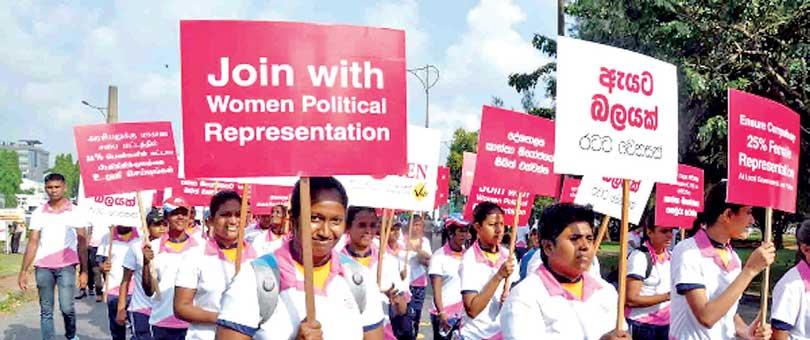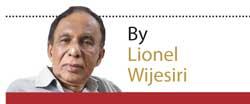Reply To:
Name - Reply Comment

 Fourteen years before the foundingof the United Nations Charter (1945) included a provision for equality between men and women, the establishment of universal adult suffrage in Sri Lanka gave our women the right to vote on the same basis as men. It was just three years after women in Great Britain and slightly more than a decade after women in the United States obtained this right.
Fourteen years before the foundingof the United Nations Charter (1945) included a provision for equality between men and women, the establishment of universal adult suffrage in Sri Lanka gave our women the right to vote on the same basis as men. It was just three years after women in Great Britain and slightly more than a decade after women in the United States obtained this right.
In 1960, Sri Lanka became the first nation in the modern world whose government was headed by a woman.
Nonetheless, despite these striking achievements and a progressive narrowing of sex differentials in education and literacy, Sri Lanka has conformed itself to a pattern of limited political participation by women, particularly in the more active and public political roles.
Today, women’s participation in Sri Lankan politics has been one of the lowest in South Asia. Among the 10 countries with the most years with a female head of state in the past 50 years, Sri Lanka has been positioned at ninth place, while Bangladesh and India were placed on 1st and 4th places respectively.
According to the latest (December 2019) rankings issued by the Inter-Parliamentary Union on percentage of women in national parliaments, Sri Lanka is positioned in 178 out of 187 countries - with a percentage of 5.33. with 12 members in the 225 membership. According to Election Commission, Women’s representation in Provincial Councils is zero, while in Local authorities is at 1.9%.
There were quite a number of research papers written during the past three decades on women’s political representation in Sri Lanka – mainly by academics and women’s rights activists. However, most of them had paid more attention to their descriptive representation – that is, numbers of women elected rather than their experience and performance once elected.
What happened?
What has gone wrong? Why is this scarcity of female candidates and elected officials? Are women uninterested, unwilling, or uncertain? Is the political system unresponsive and impenetrable?
A Women’s rights activist, a personal friend, summed up: “Ultimately, is the issue the driver or the road?” He volunteered to offer his answer: “We all know both the driver and the road matter to any journey. In particular, the driver’s perceptions of whether she will face smooth road conditions or stop-and-go heavy traffic will influence her choice to take or avoid a certain route.”
He has a valid point. Sri Lankan women contemplating running for political office are strongly affected by the costs and benefits they anticipate from a candidacy. The road conditions appear to differ for women; the roads on which men travel have fewer potholes and roadblocks than those navigated by women.
So, isn’t it time we take a hard look at the reasons behind the continuing lack of representation of women in politics, even after the legal provisions are in favour of them.
Role of political parties
There are 70 recognised political parties in Sri Lanka. However, less than 10 of those parties can exert a worthwhile influence among the voting public. For their own reasons, most of them have shown only limited commitment to enhancing women’s political representation. Only the smaller parties and independent groups have given reasonable number of nominations for women candidates.
Political parties’ practices, policies, and values can have a deep impact on women’s political participation and representation. Indeed, they are key organisations which nominate candidates in local and national elections, provide campaign funding, rally voters, set policy and governance priorities, and form governments.
Unfortunately, with few a exceptions, political power in Sri Lanka is open to a narrow socio-economic group of women in Sri Lanka. Dr. Ajantha Perera, academic, scientist and environmental activist speaking to a Sunday newspaper recently commented, “If we take a closer look at Parliament and the female parliamentarians who are there, except for one female Member of Parliament, the rest of the women MPs are there due to their connections to male MPs; they are appointed to the seat that was made vacant by the demise of their father or husband.”
She is right. In a patronage-based political and electoral system with no controls on party finance, women are at a distinct disadvantage, with fewer economic resources and less access to male-dominated clientelist networks. In spite of constitutional guarantees, successive male-dominated governments have done little to address women’s economic and political exclusion.
Sad truth
We may brag that our law allows for women to enjoy equal opportunities and equal rights like men. However, in practice the woman is only a second-class citizen in the county. It is accepted that Sri Lanka is a patriarchal society. Therefore, the due recognition of the woman is denied under the influence of male dominated thinking and decisionmaking. Their dominance renders feminist discourses silent. .
The sad truth is unequal representation of women in decision-making bodies is an obstacle to achieving gender equality in society and the fulfillment of the Sustainable Development Goals.
The Local Authorities Elections (Amendment) Act No. 1 of 2016 sought to address this gap by introducing a mandatory quota of 25% for women through a one-third increase in the total number of seats at the local government level, Pradeshiya Sabas, Urban Councils and Municipal Councils. It is too early to say whether this measure will give a positive outcome as expected.
Understanding the problem
If the Government genuinely wishes to promote women’s equal and full political participation to be effective, it should find ways to enforce the political parties to ensure that their constitution, structures, processes, and financing are gender responsive and inclusive of all women. It is crucial that political parties encourage women’s participation and integrate gender equality issues in their policies and programmes to ensure diversity of views and no one is left behind.
As a first step,the government needs to get a better understanding of the current situation. For example, answers are needed to a number of questions. (1) Do political parties in our country publicly express commitment to gender equality? If so, is this commitment reflected in their actions (e.g. leadership structure, candidate nominations, campaign financing, and policies)? (2) What can political parties do to promote women’s political participation and representation within their organizations and in politics in general? (3) What can they do to better include young women, women with disabilities, and indigenous women? (4) Are we aware of instances where political parties gained greater electoral success following the implementation of gender affirmative action measures? (5) Violence against women in politics is a widespread phenomenon. What can political parties do to stop it?
Those questions relate to political parties. There are issues related to women as well. (1). What factors influence women’s ability to become politically represented, (2). What factors may influence women’s ability to be effective politicians? (3). Do women politicians promote gender equality and/or represent the interests of other women? (4). How could the Government and people support to prospective and elected women politicians improve their work quality?
To find comprehensive answers to these questions, we need quantitative data to look at trends and qualitative data to understand the process of women’s decision-making and political influence. I do not think presently we have enough solid material to cover both angles. That means, we need to do a comprehensive survey to find out the answers. The survey must include both closed and open-ended questions, and must use mixed-methods approach to both data collection and analysis.
Finding solutions
So, what should the women’s organisations and other interested NGOs need to do? (1) Identify and support future women’s leaders and their diverse pathways into politics. Identification must be done not on political basis. (2) increase the social and economic capabilities that are instrumental for women’s political power, in particular higher education and economic capital. (3) Long-term relations with the civic associations through which women acquire political skills and resources. (4) Persuade the party leaders (including at sub-national levels) to search for and attract potential women leaders. (5) Level the electoral playing field. The last point needs elaboration.
Level the electoral playing field – is an intensely discussed point in the past. My personal opinion is that the gender gap in elected office could be explained by the fact that few women are willing to run for office to begin with. This is an important factor missing from conventional explanations for this gap. In the beginning of the article. Women are much less willing to compete in elections than men, even if they are equally qualified and equally confident in their abilities. There is something about elections themselves that put off potential women candidates.
The point is that women and men do not face a level electoral playing field. It is the issue of the driver or the road. For example, men have more access to the funds necessary to run, they have fewer family obligations, and they even have more electoral ambition and are more likely to think about running for office than women. If we could create a situation in which the electoral playing field really is level and if women and men faced the exact same costs and benefits to running, I am confident women’s willingness to run will vastly improve.
Women’s organisations must seek the support of other NGOs to raise awareness among women about the importance of their participation in politics. As a starting point of the long journey, it may be a good idea to fight for the achievement of 25% quota for women.